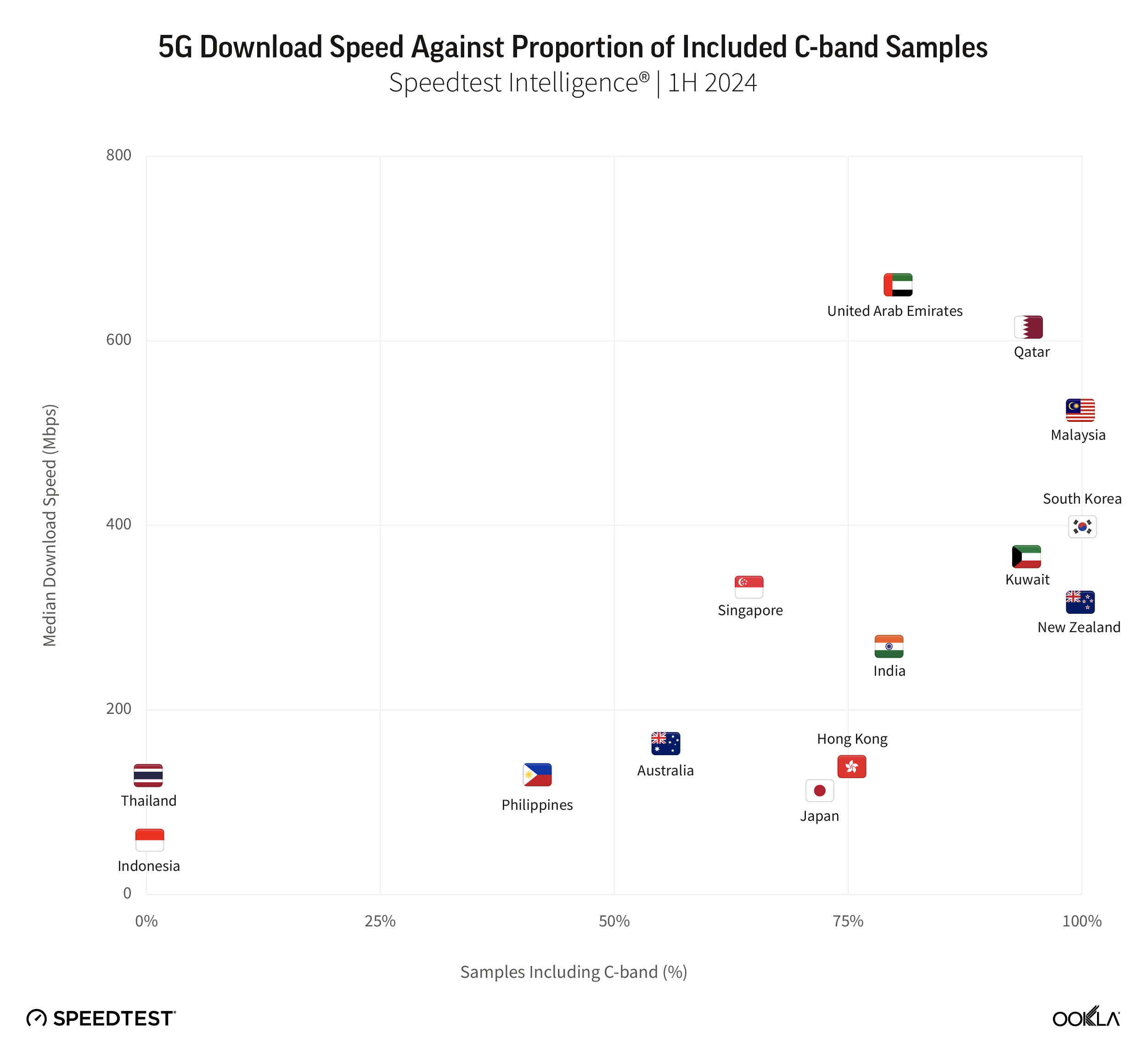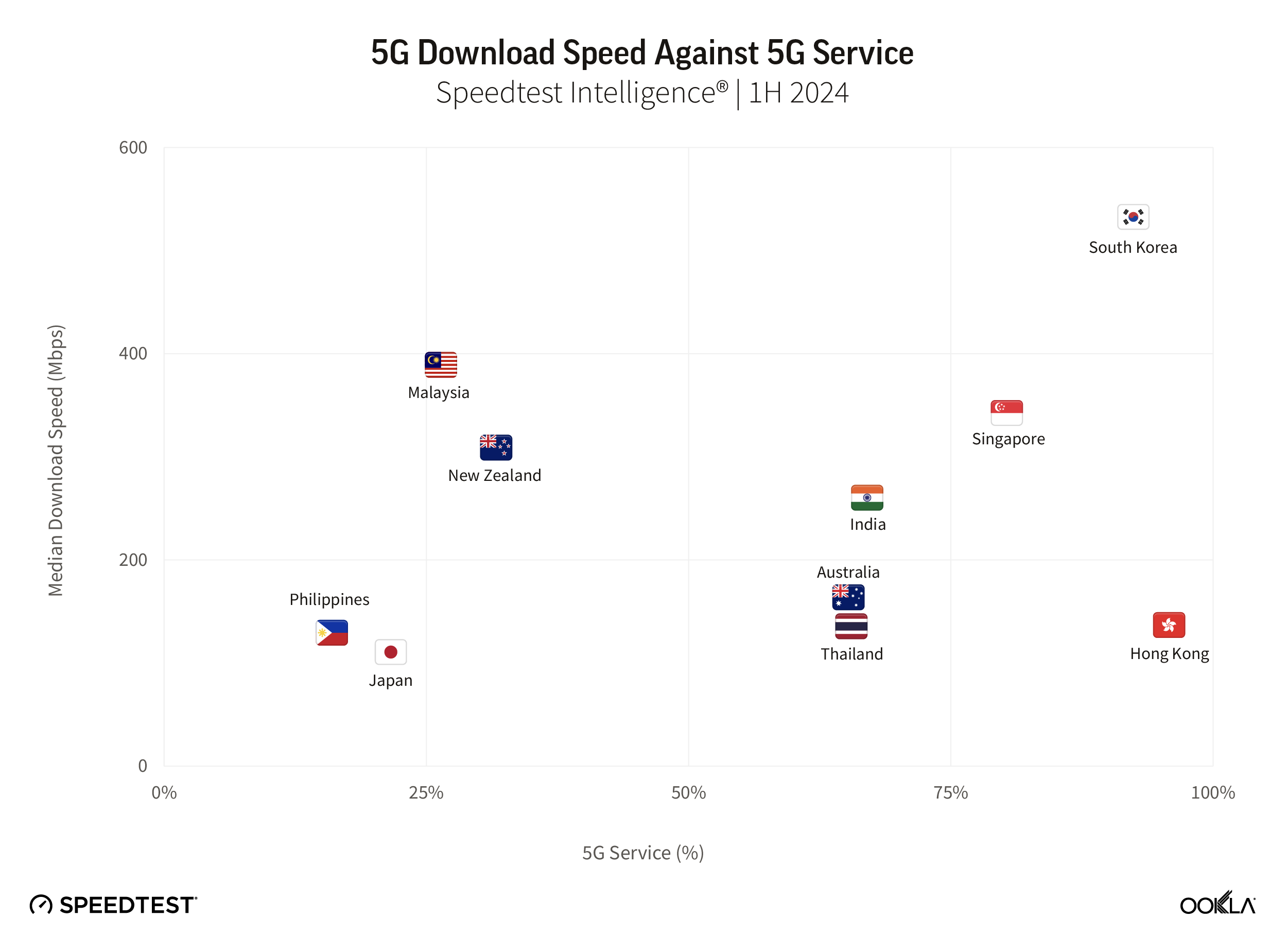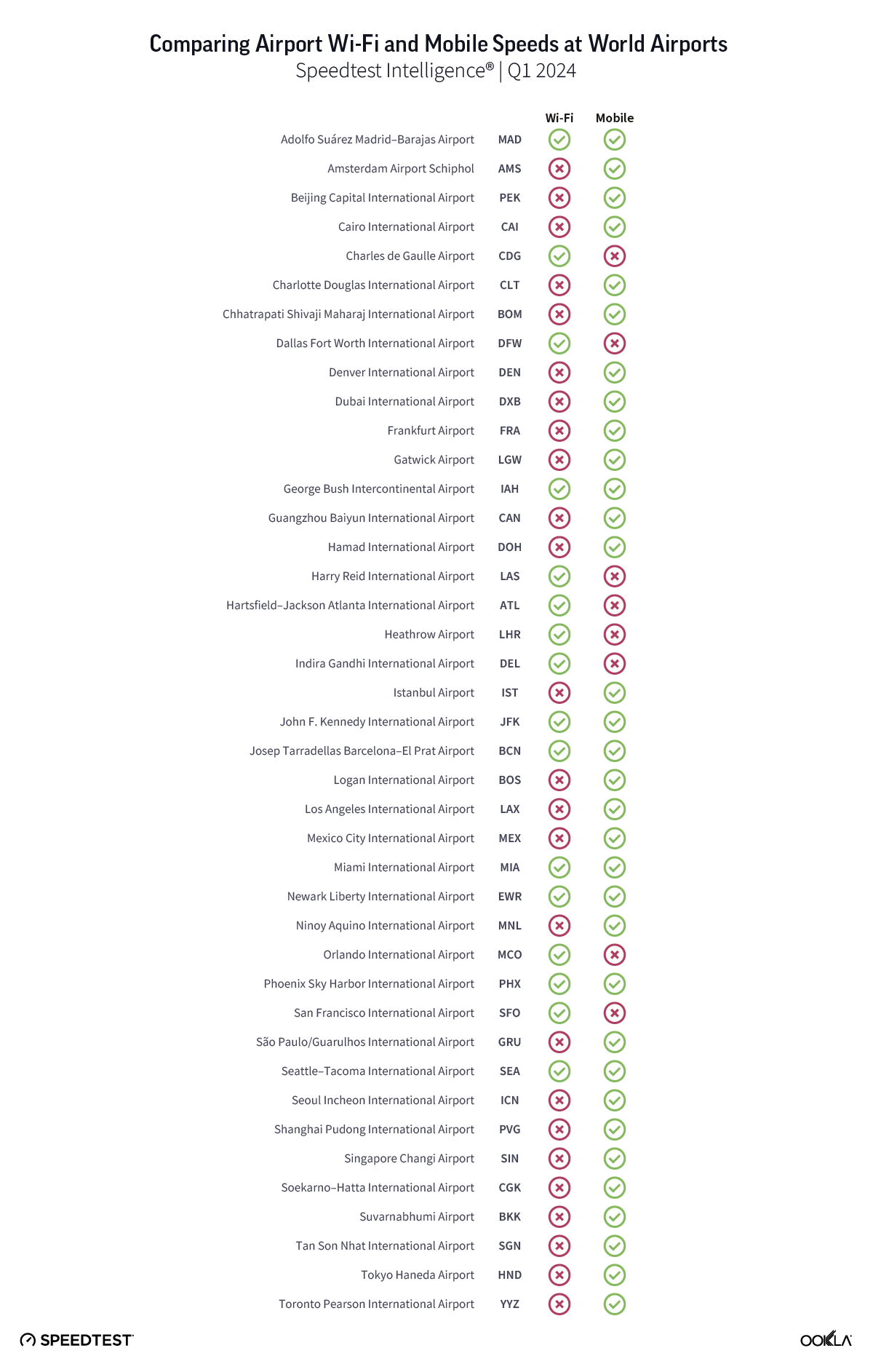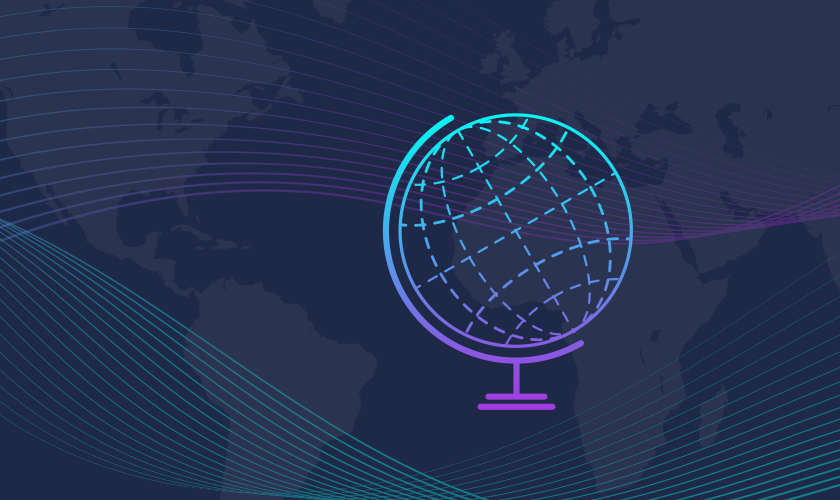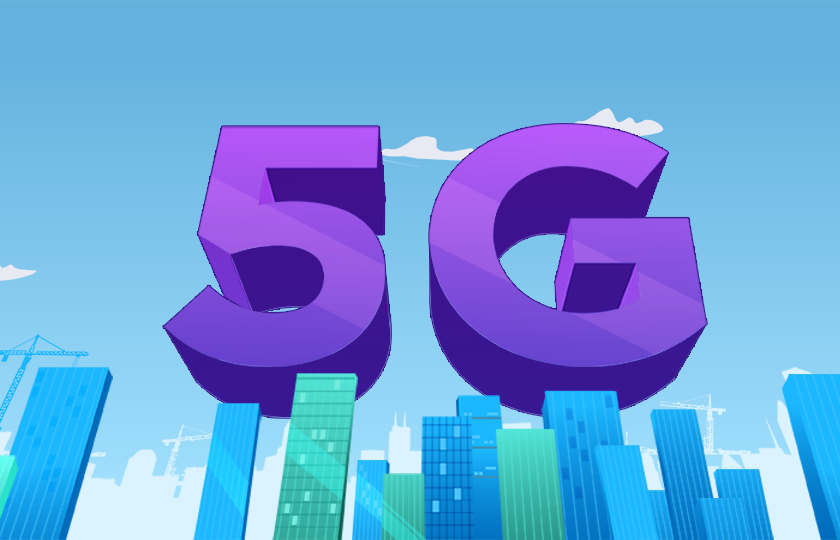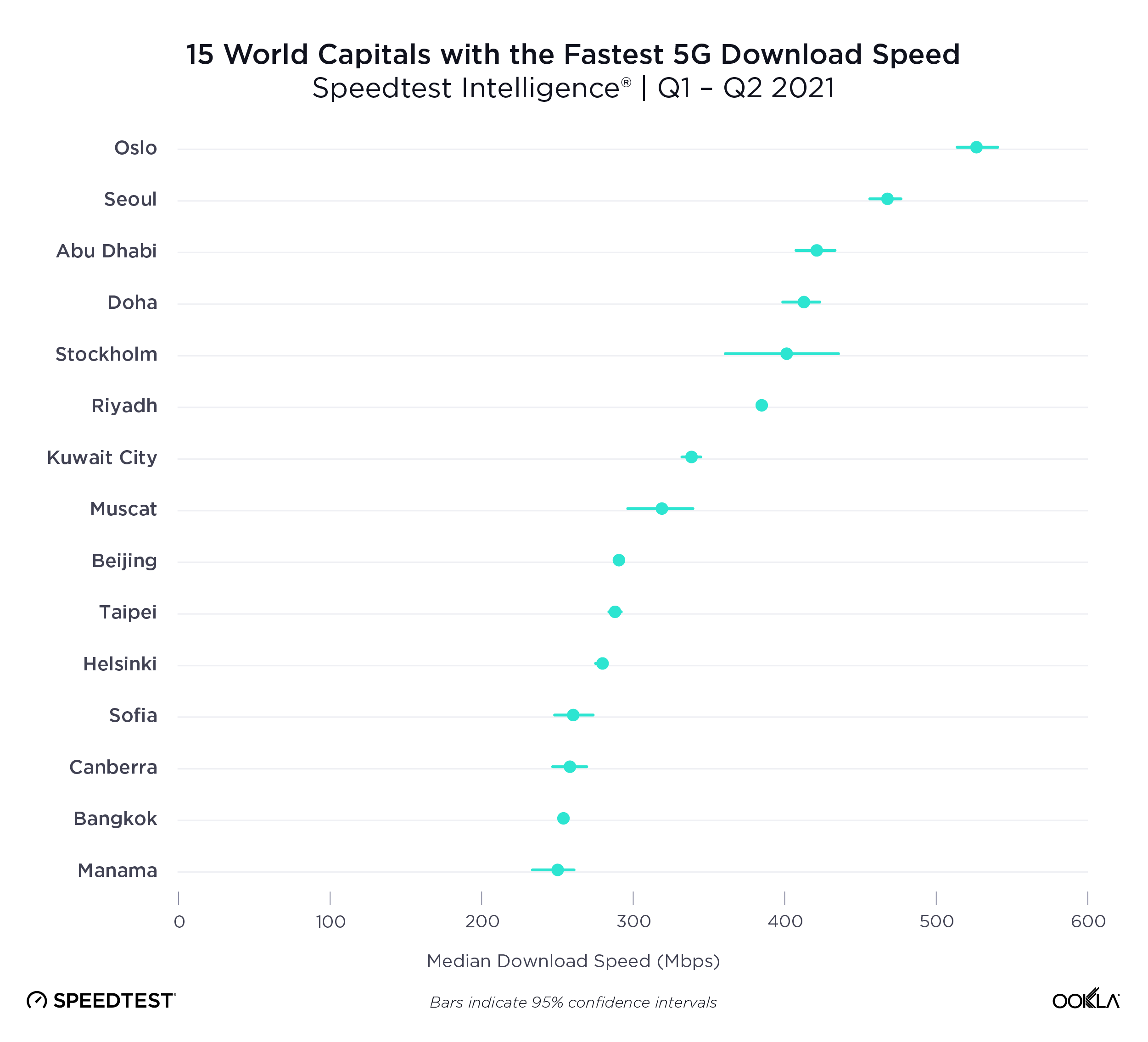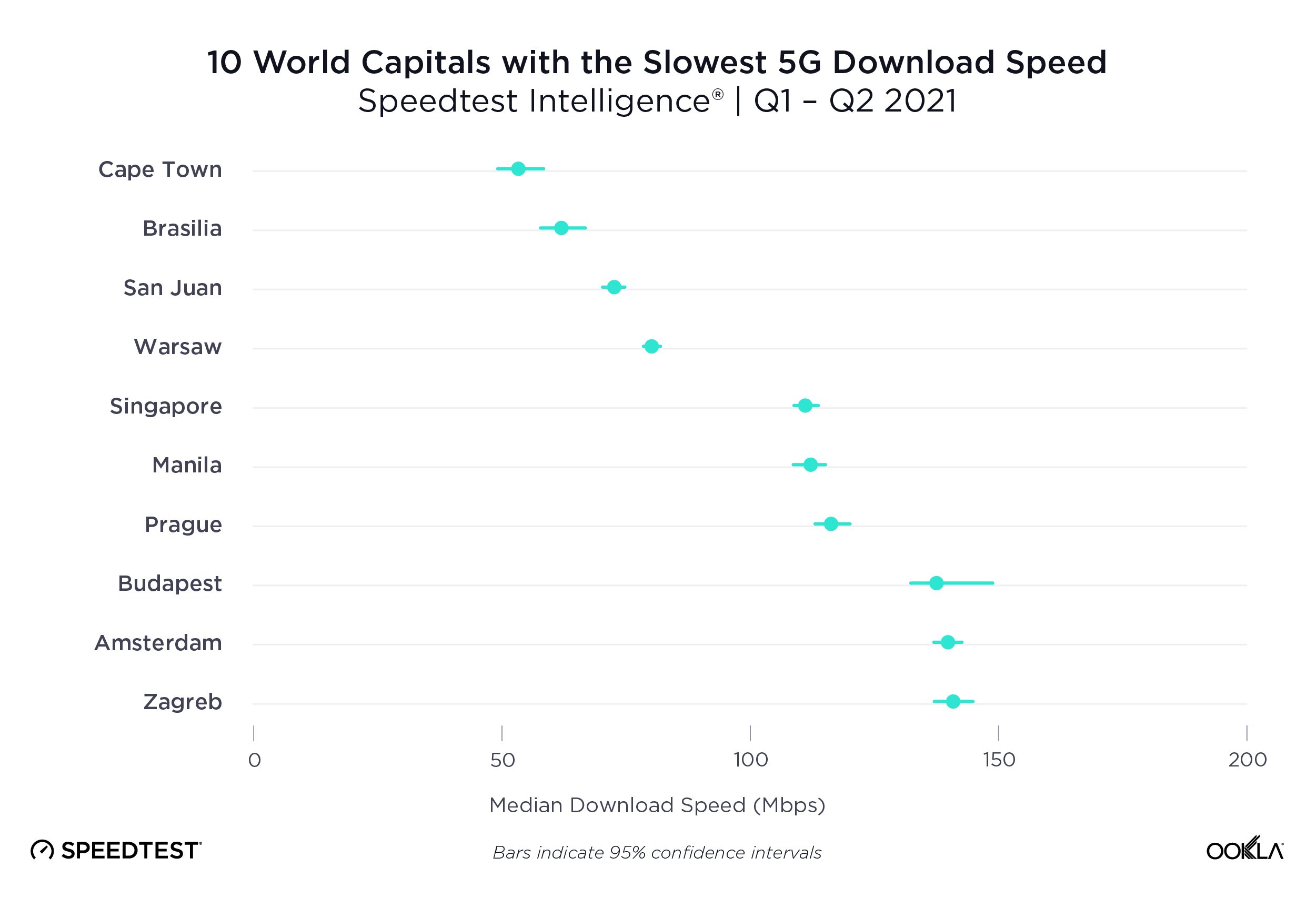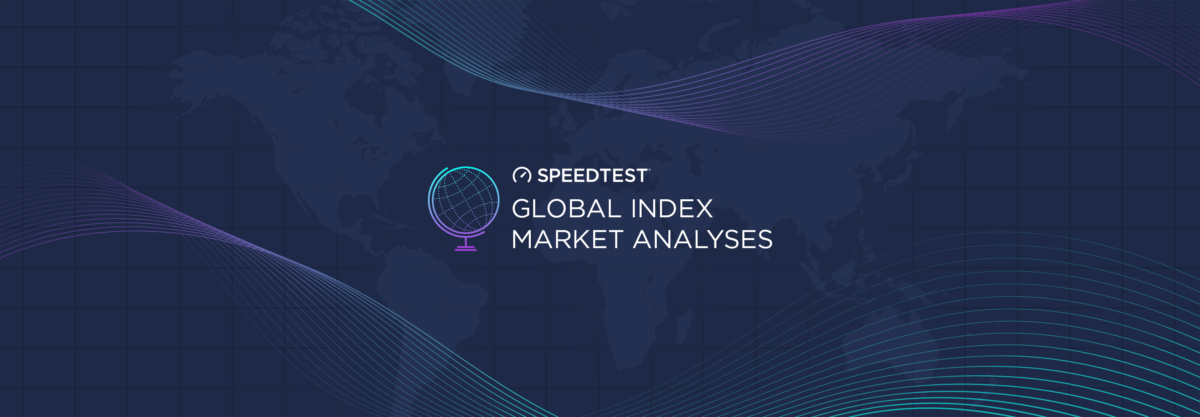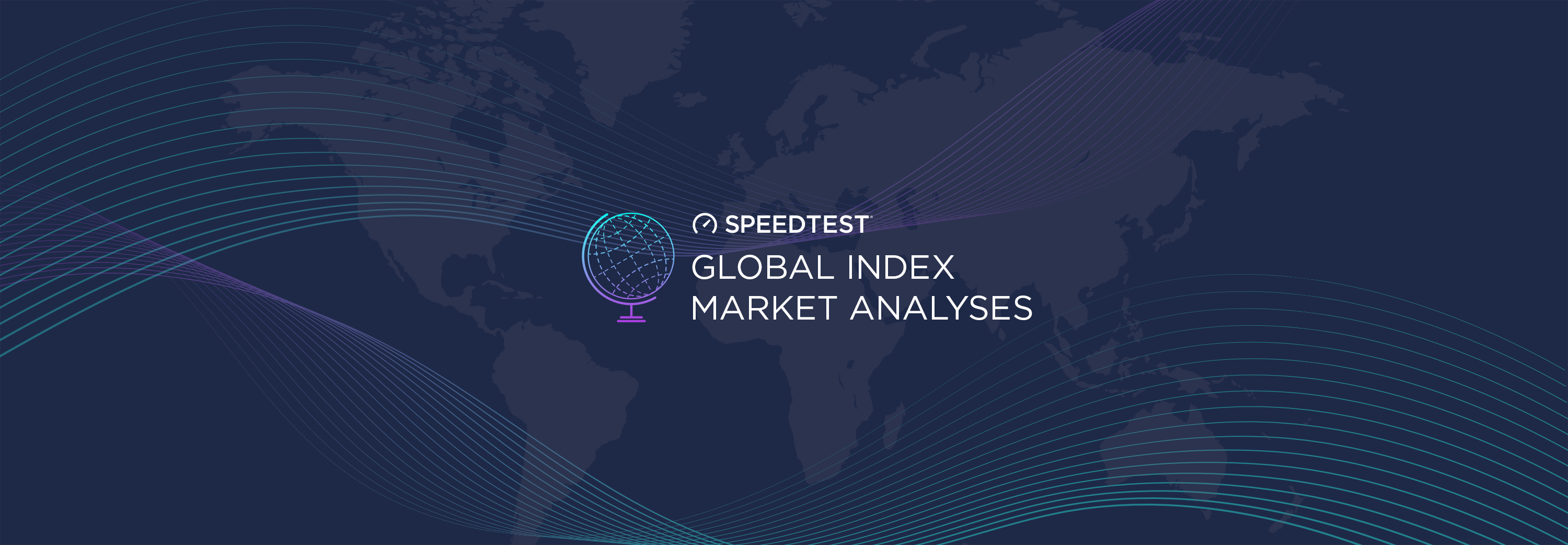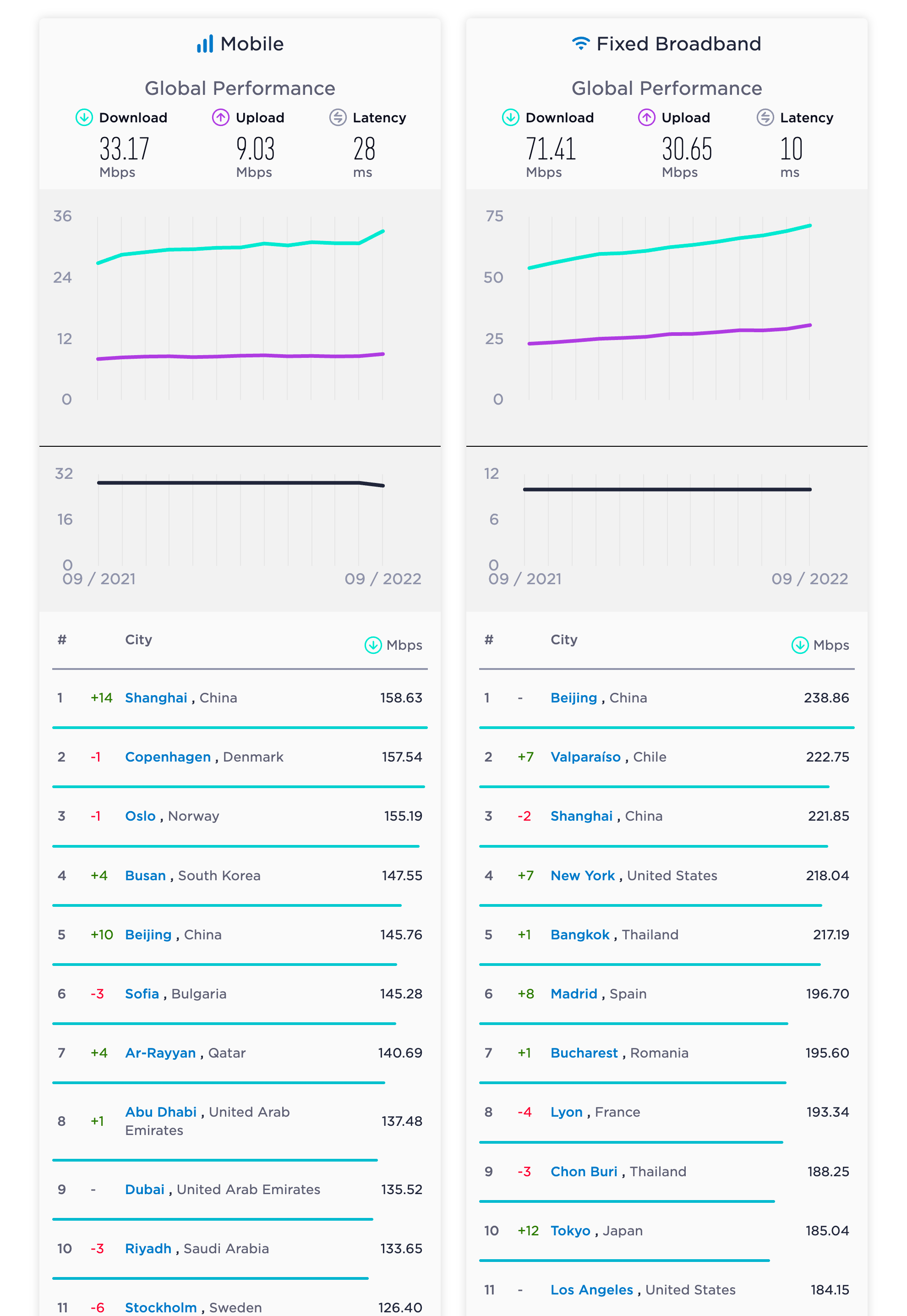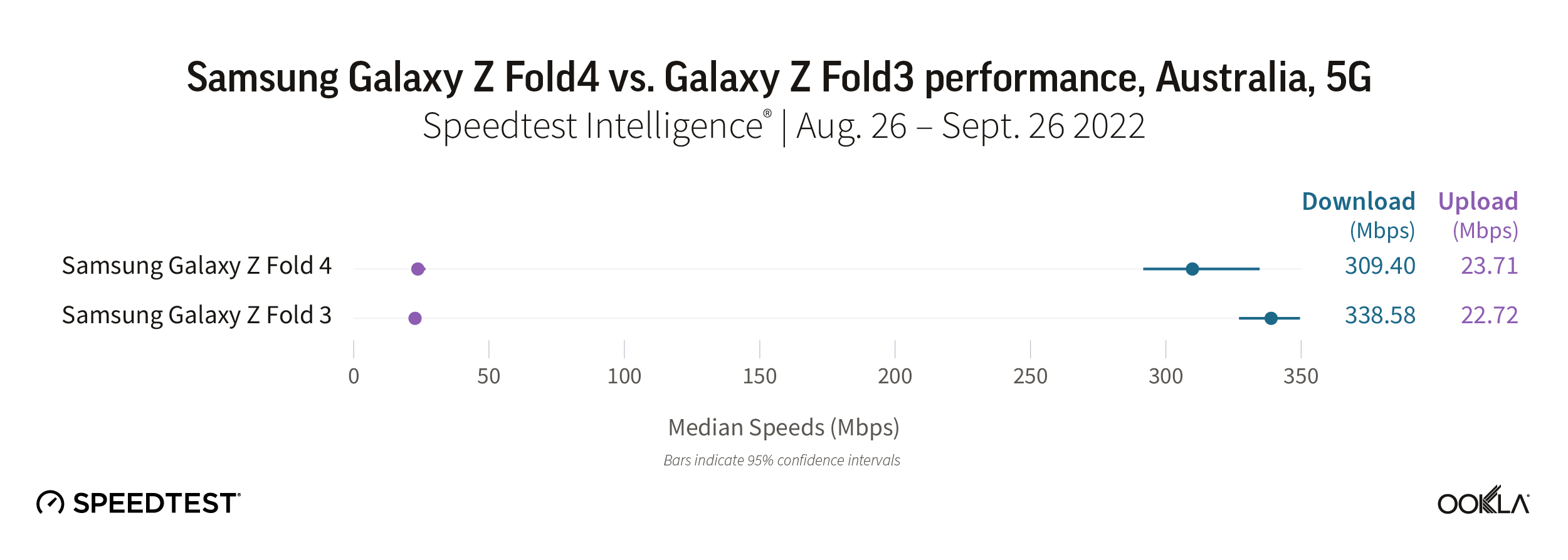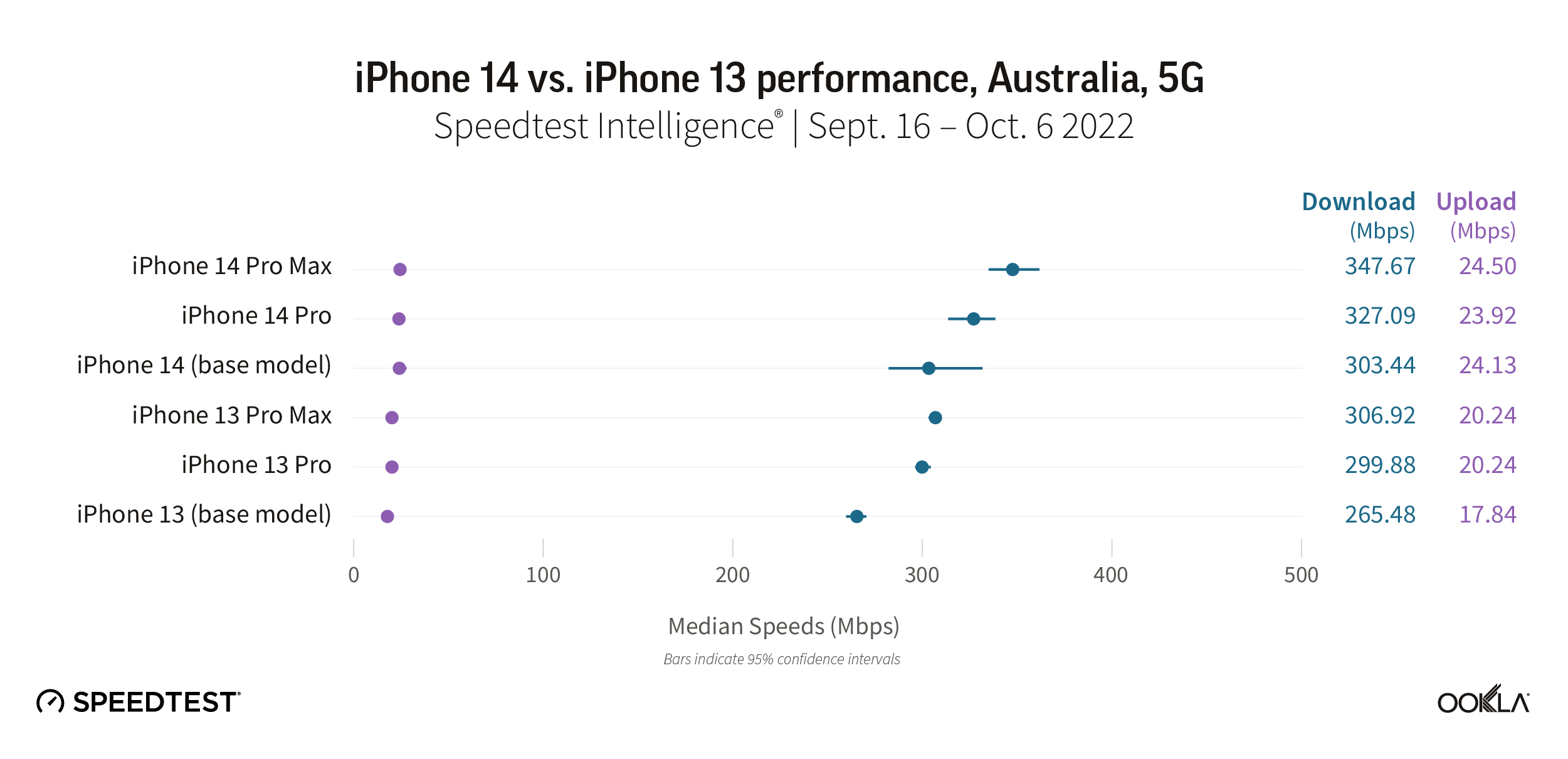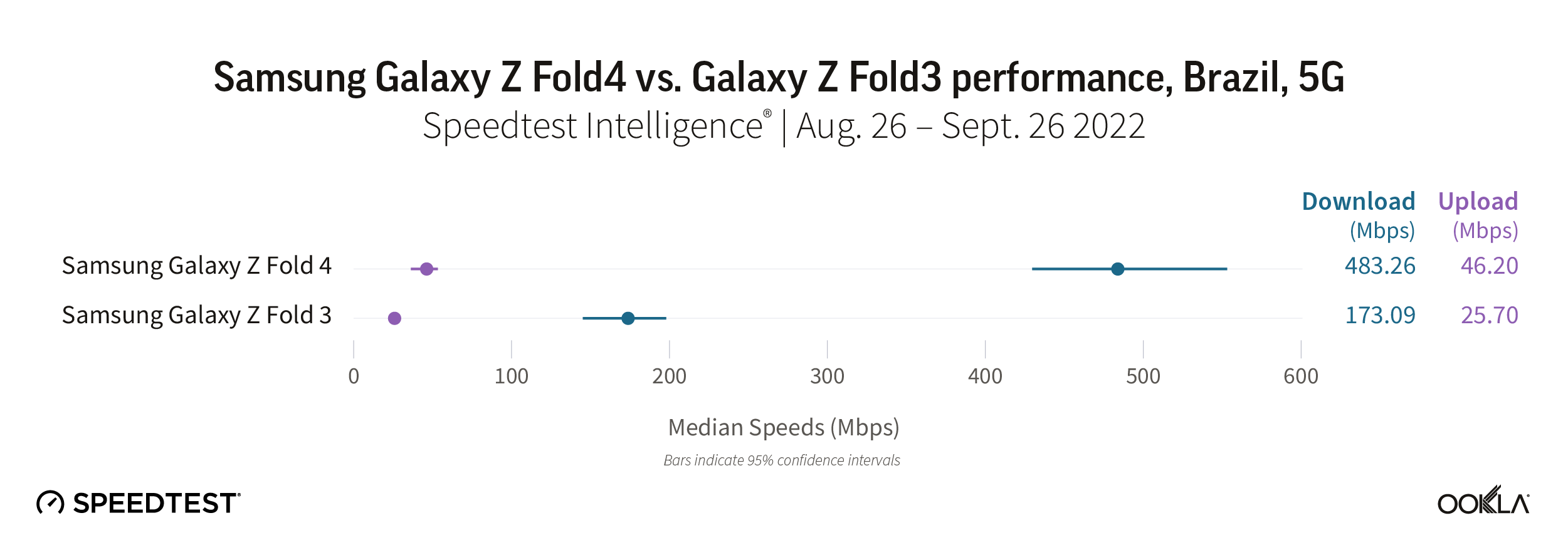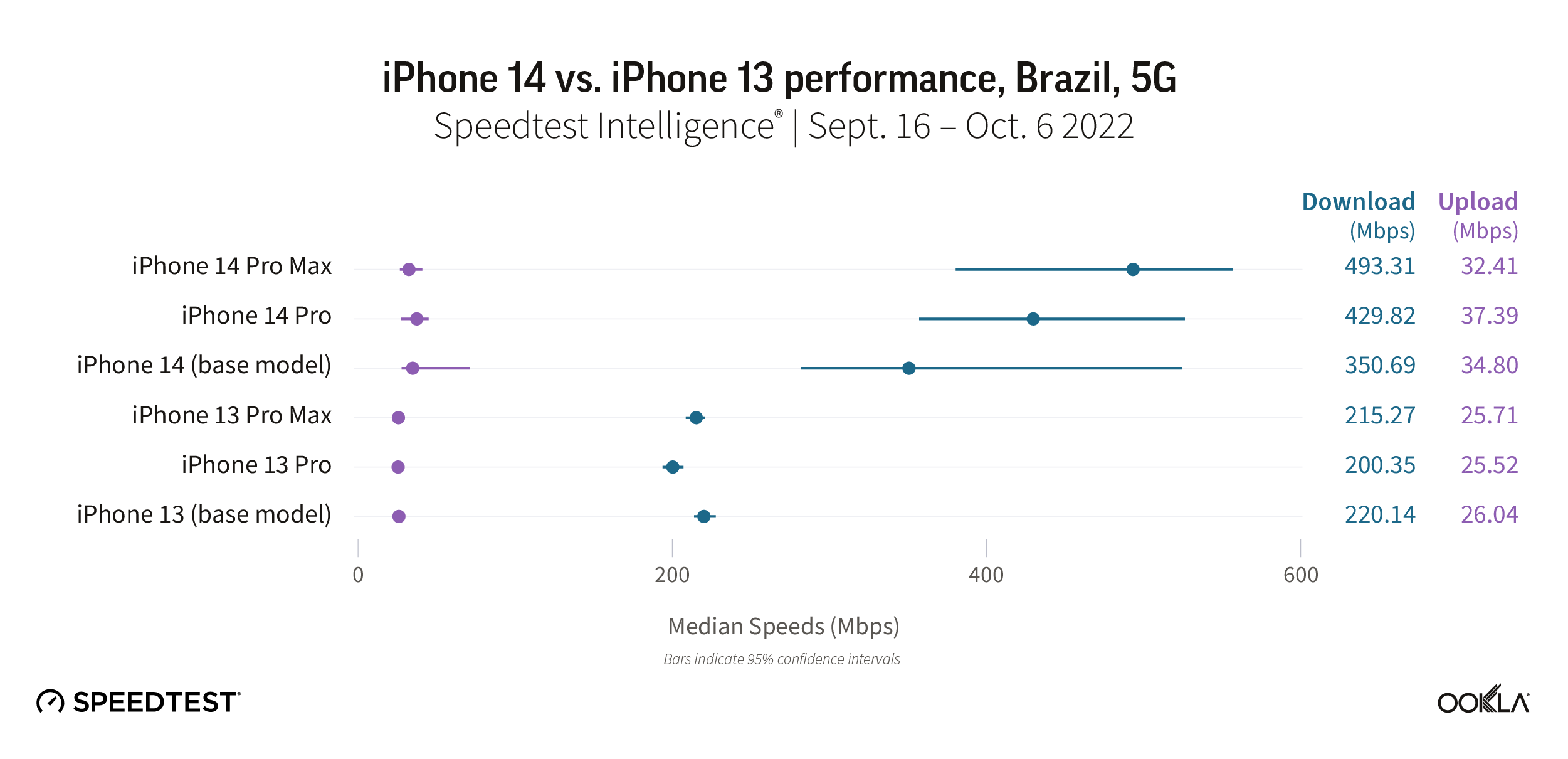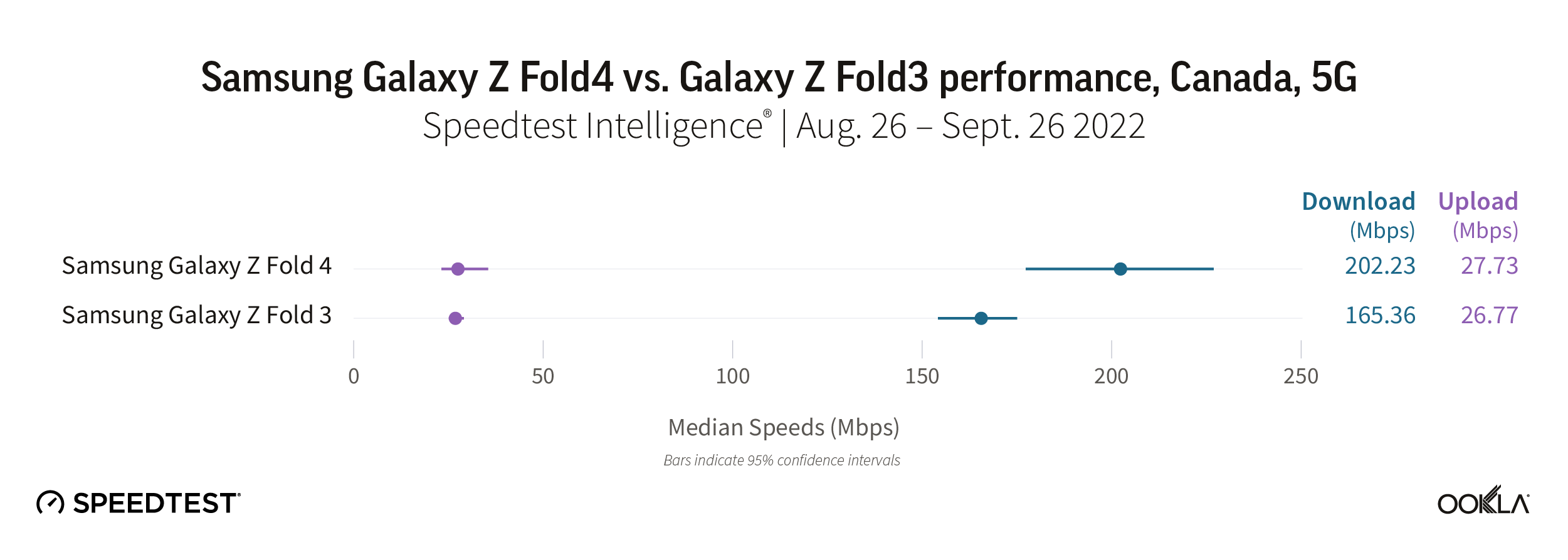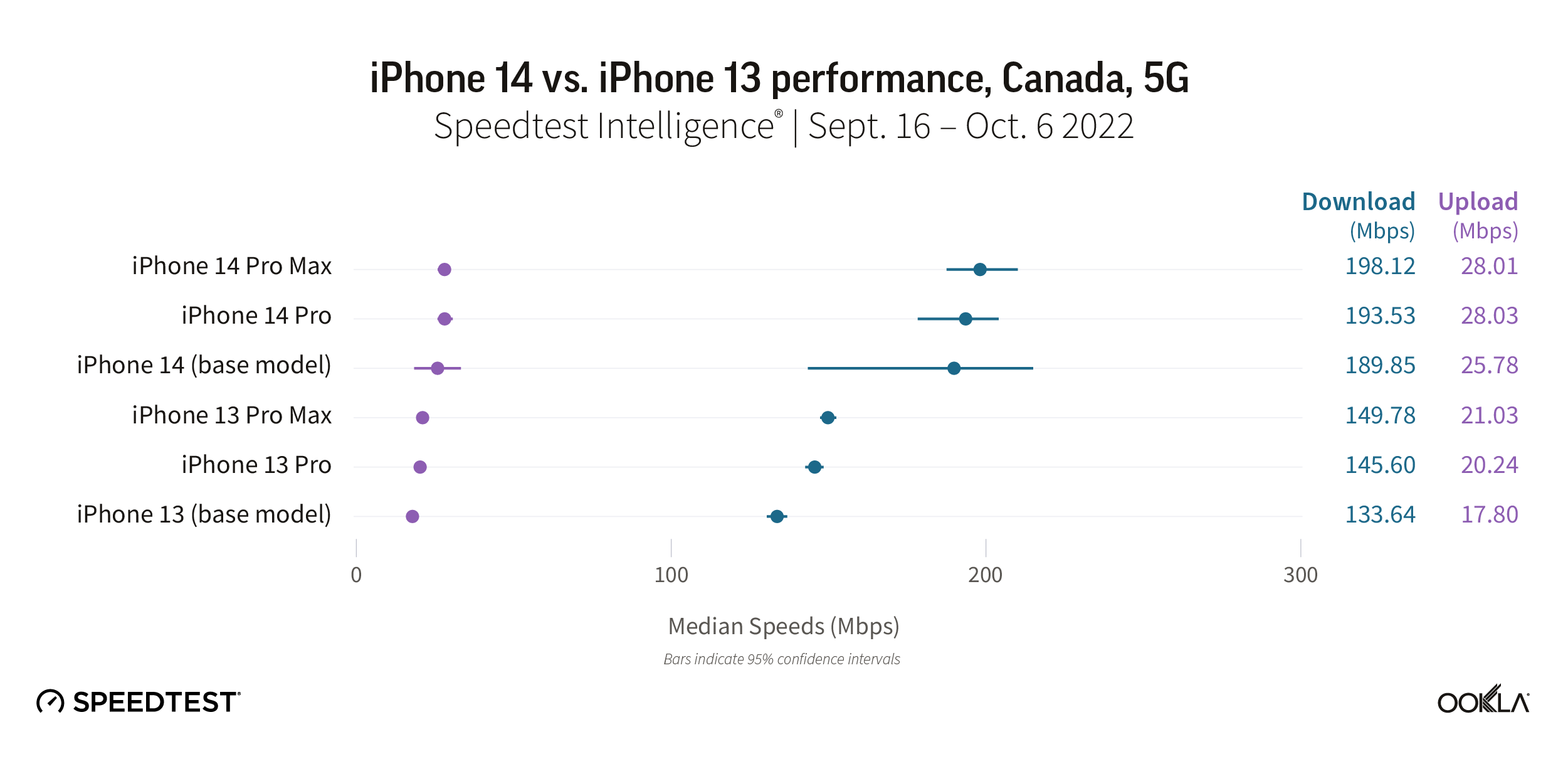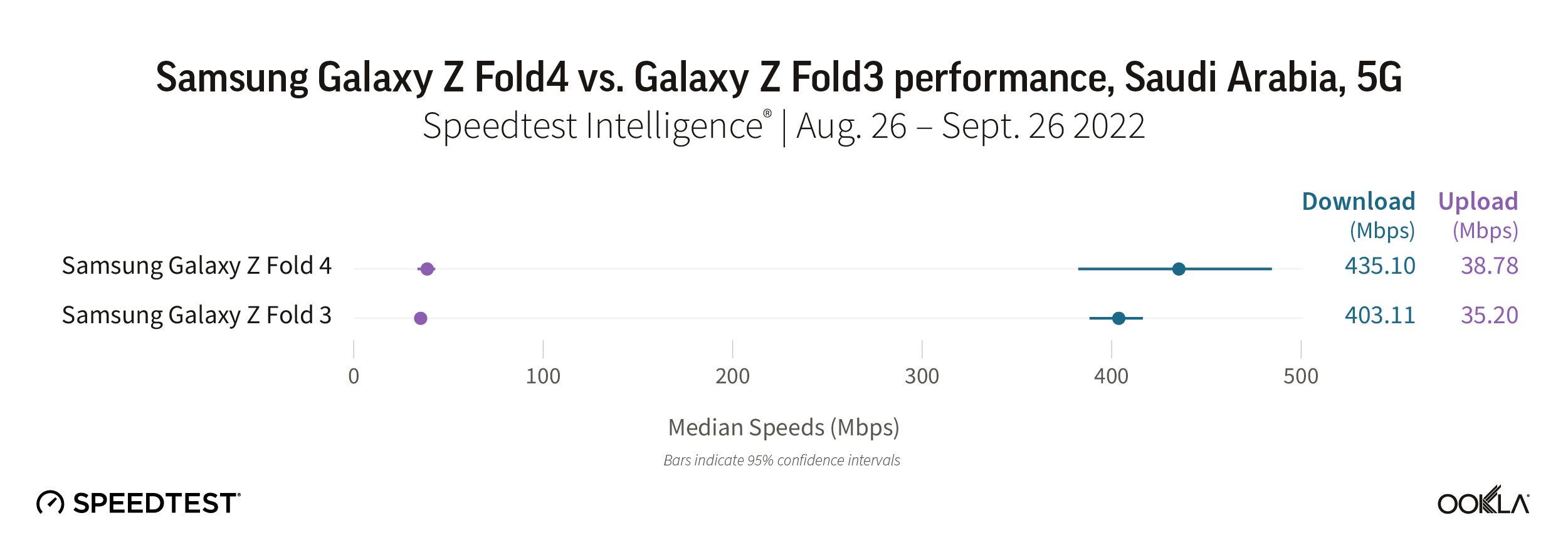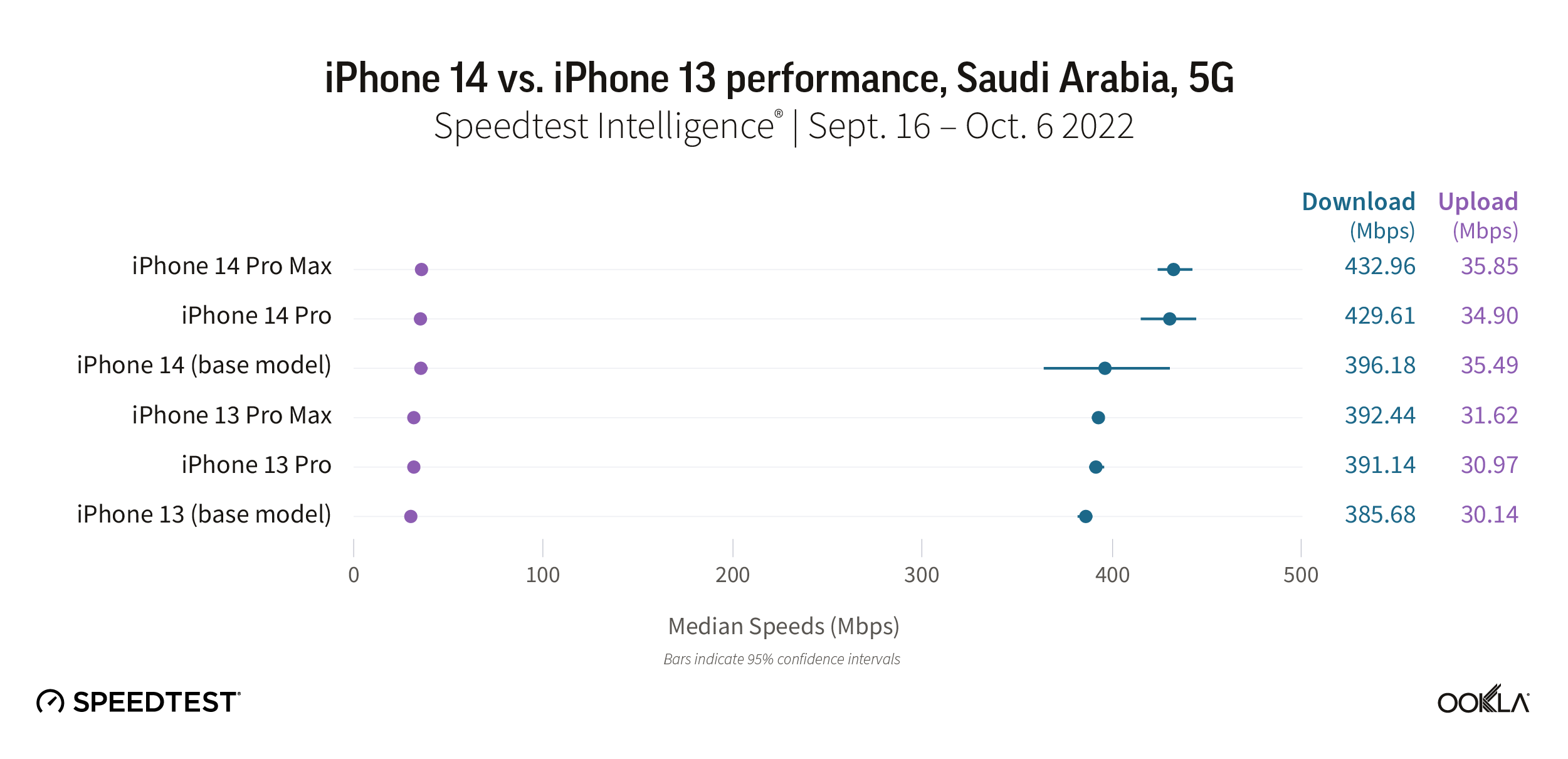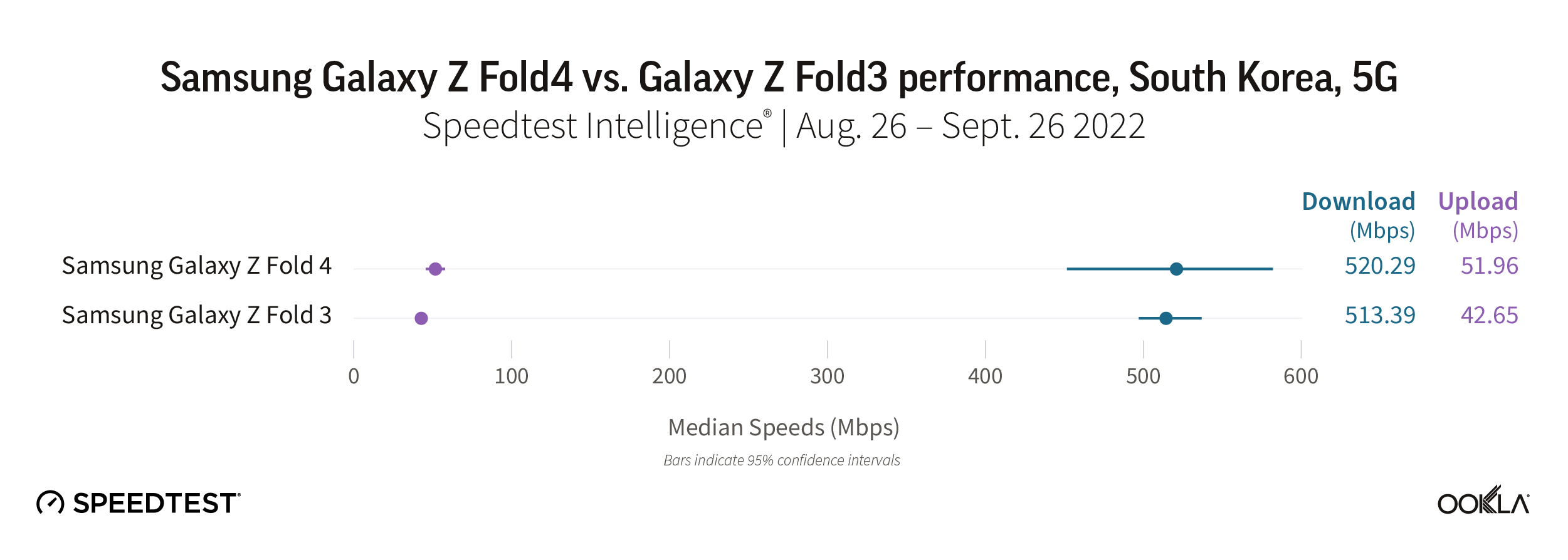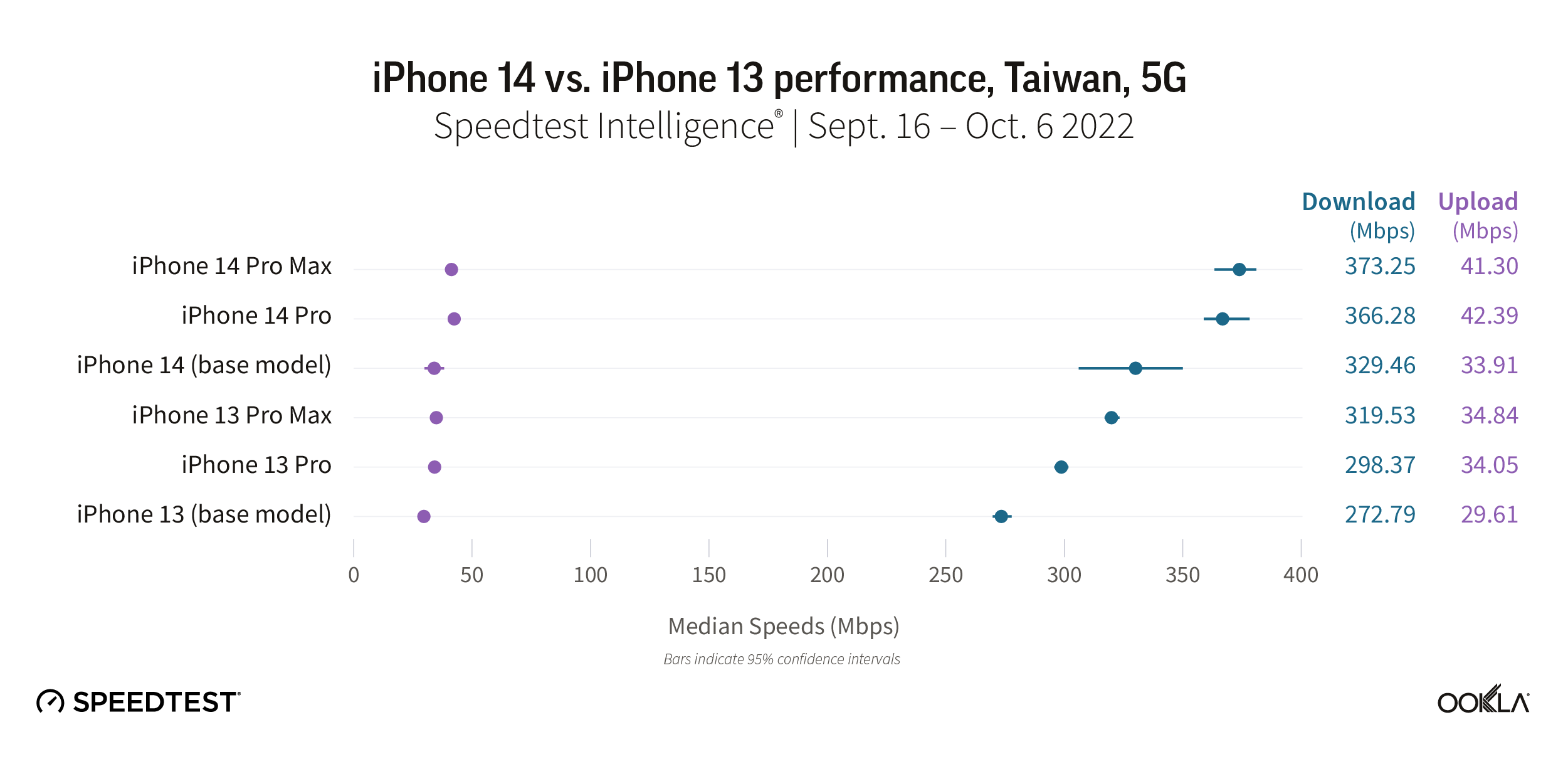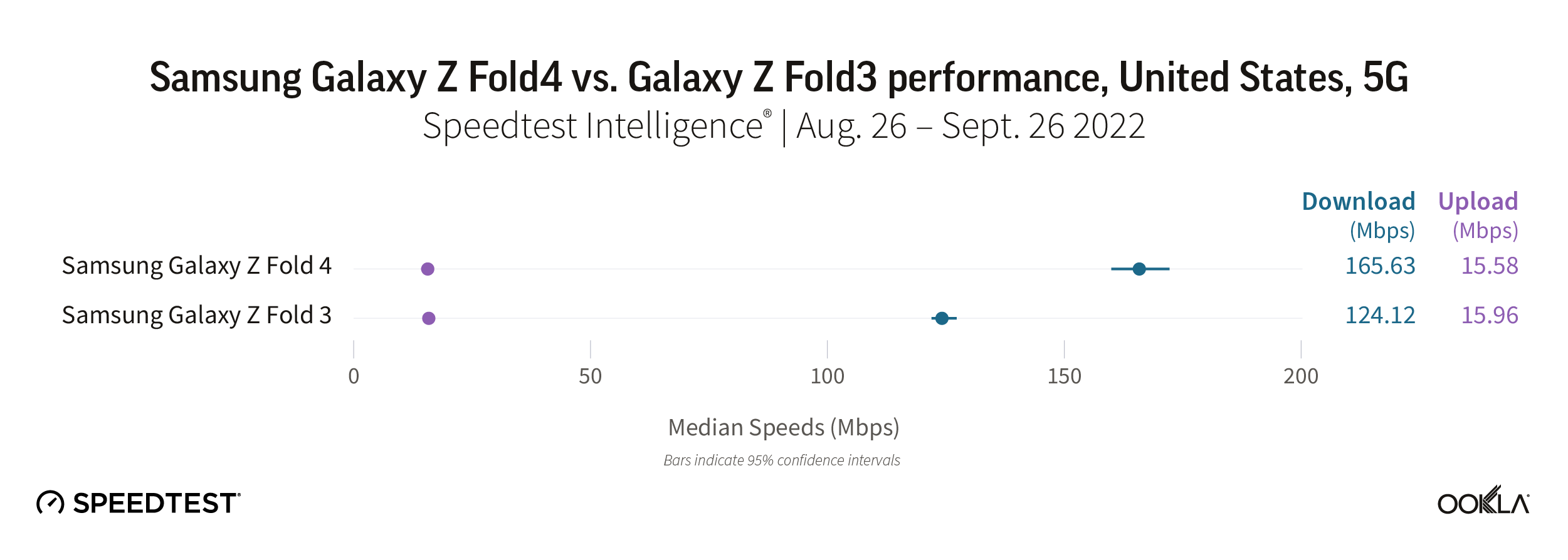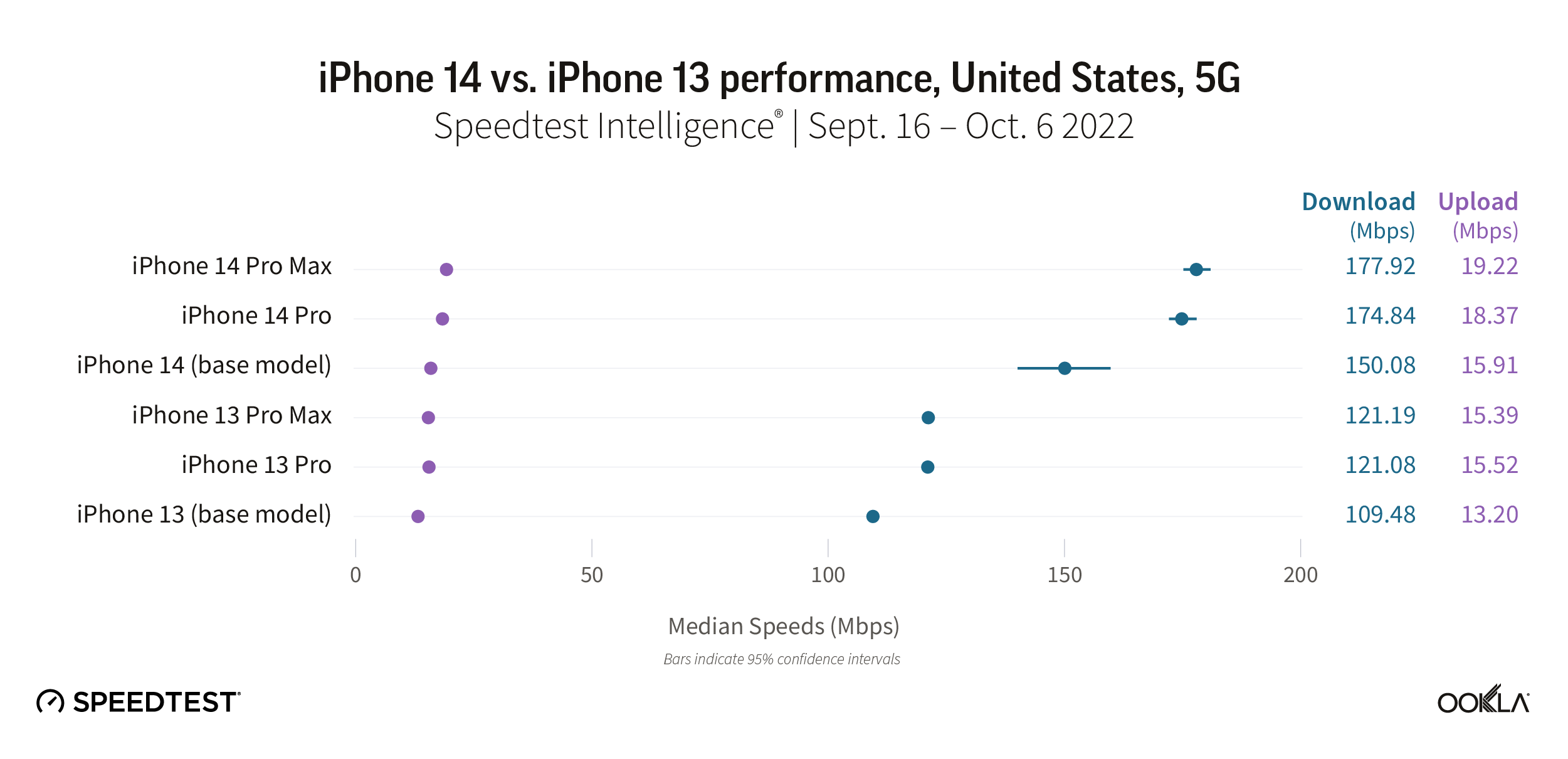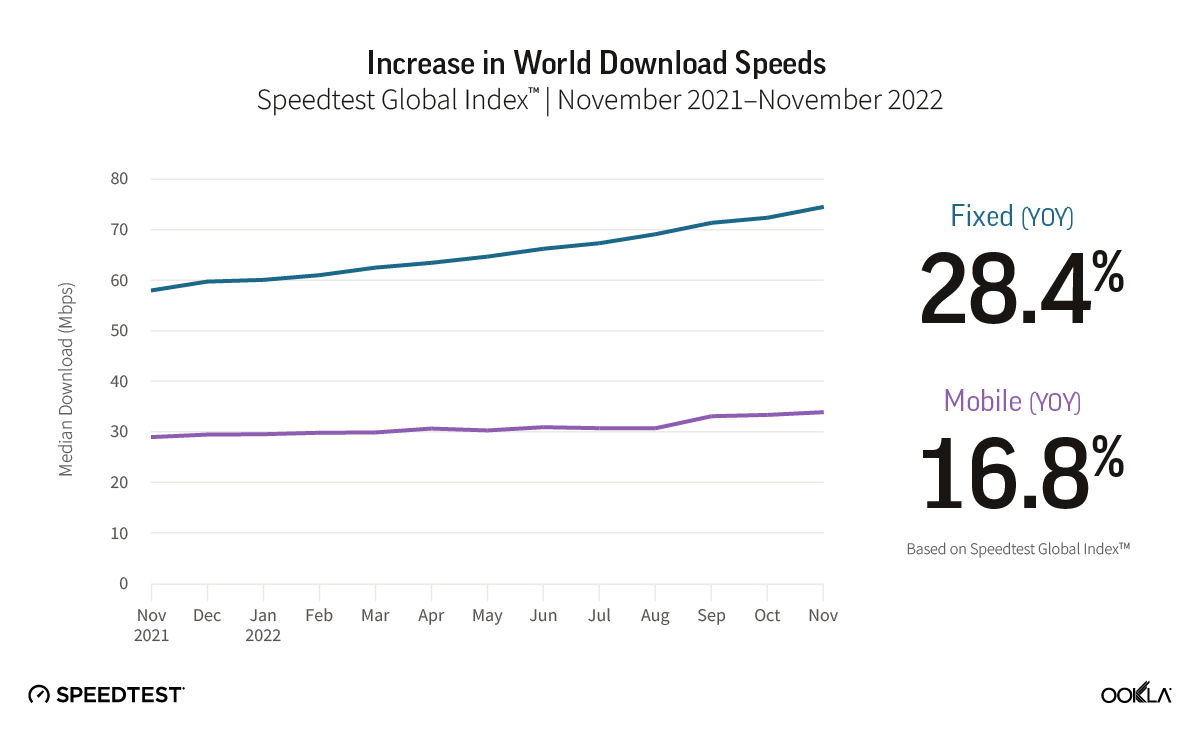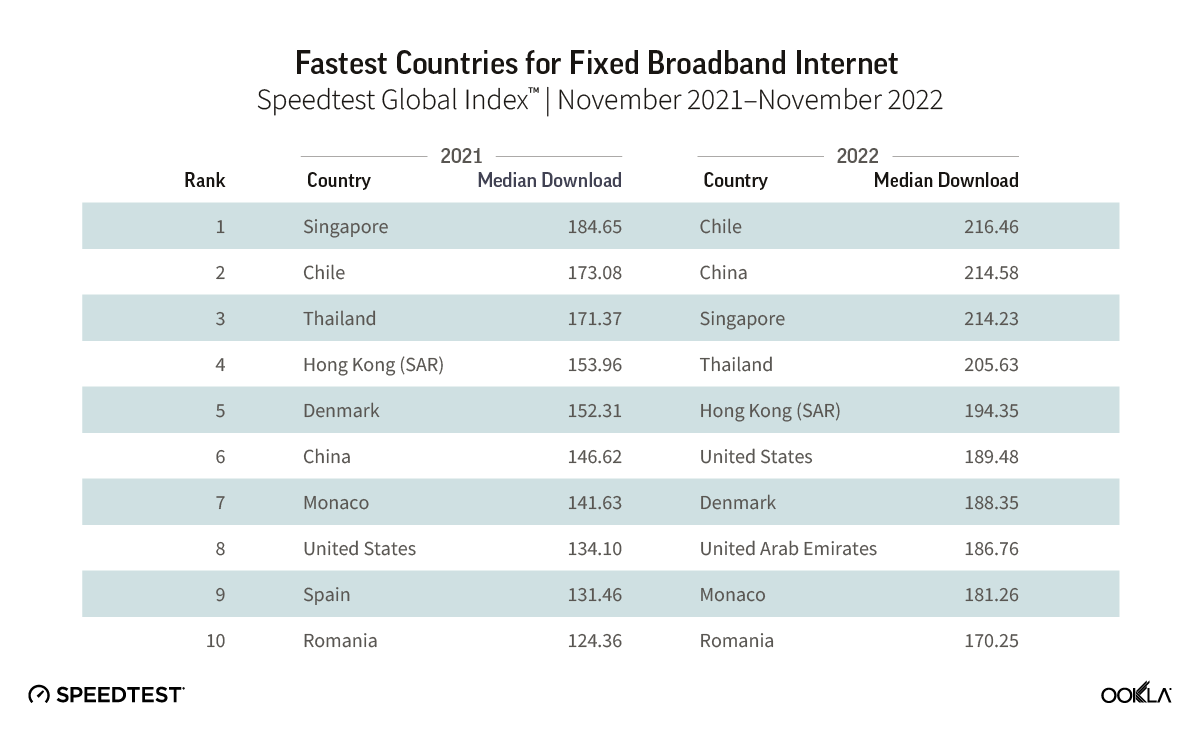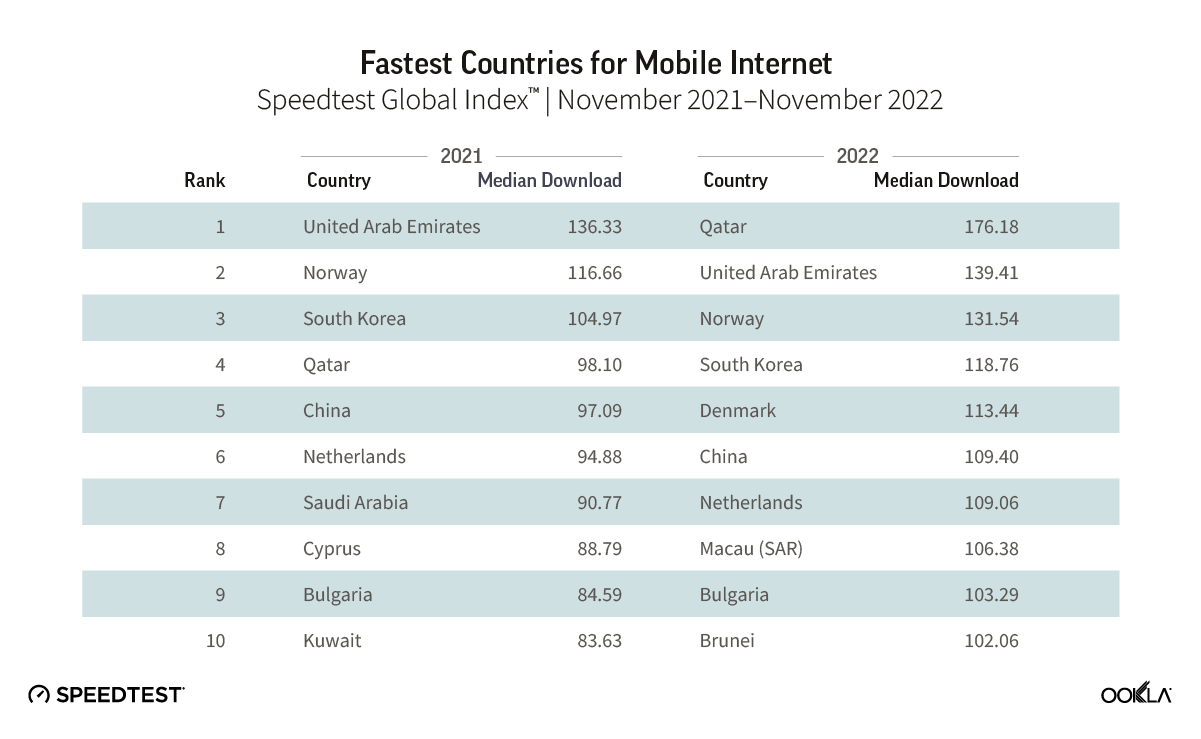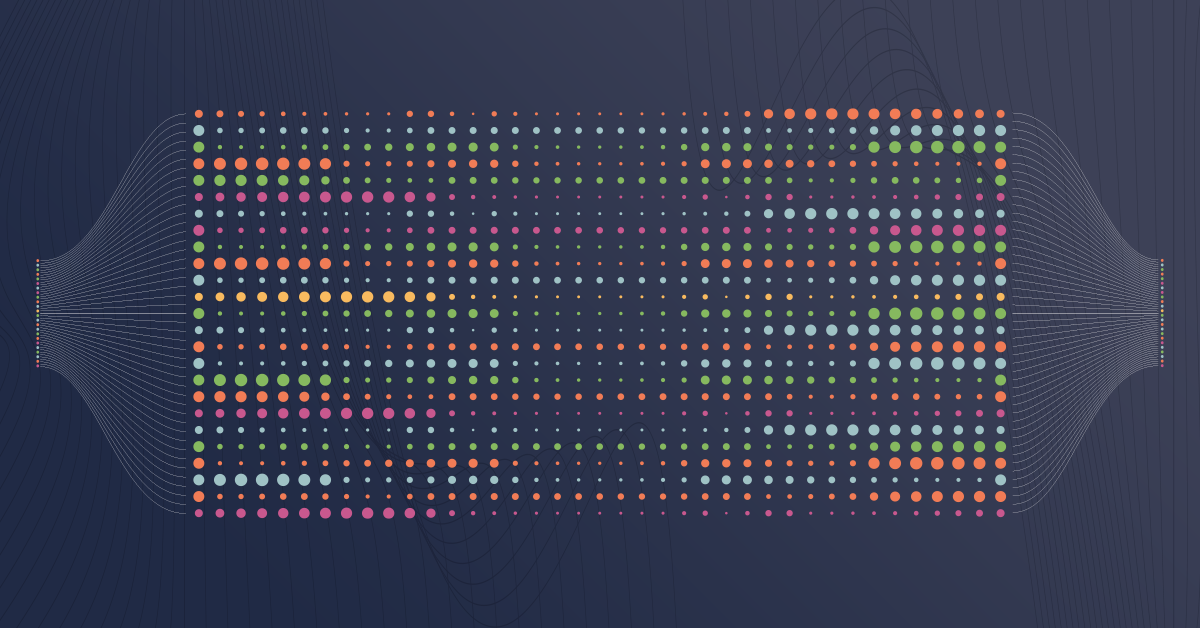In the dynamic landscape of 5G deployment across the Asia-Pacific region, the strategic selection of spectrum frequency bands plays a pivotal role. The mid-band range, notably C-band (3.3-4.2 GHz), stands out as a key enabler, offering the ideal balance of broad coverage and high capacity. In this article, we use Ookla Speedtest Intelligence® data to highlight the relationship between spectrum bands and network performance.
KEY TAKEAWAYS
- Mid-band is important for unlocking the full potential of 5G. The mid-band spectrum offers a balance of speed and range and is the preferred choice for most 5G deployments globally. Speedtest Intelligence® showed that C-band was present in 62.1% of global Speedtest consumer-initiated 5G samples in the first half of 2024.
- Markets with a higher proportion of included C-band samples experienced faster 5G speeds. Global Speedtest Intelligence samples that included C-band were 1.7 times faster than lower mid-band spectrum and 4.27 times faster than sub-1-GHz low-band based on 1H 2024 data. Data also indicates that for markets with a higher reported proportion of included C-band samples typically experienced faster 5G speeds and improved overall network performance.
- Operators face the challenge of balancing the need for broad 5G coverage with the desire for better performance. Some APAC markets experienced a decline in speed as 5G services and availability have increased. Malaysia, with its unique single-wholesale 5G network, showed declining 5G median download speeds, falling from 506.96 Mbps in Q2 2023 to 387.39 Mbps in Q2 2024, as 5G Service increased from 9.4% in Q2 2023 to 26.5% in Q2 2024. Thailand, on the other hand, achieved a 5G Service of 65.4% in Q2 2024, but reported a lower 5G median download speed of 135.30 Mbps due to the lack of C-band allocations.
Mid-band spectrum dominates 5G deployments
In our previous report on spectrum and performance, we discussed how the effectiveness of 5G networks depends on the strategic use of spectrum bands. Regulators allocate spectrum for 5G networks across three ranges: low-band (sub-1GHz), mid-band spectrum (frequencies between 1 GHz and 6 GHz), and high-band or mmWave spectrum (24 GHz and above), each with unique characteristics and capabilities. An operator’s spectrum holdings play a crucial role in determining its 5G deployment strategy and the range of services and experiences it can offer.
Mid-band spectrum occupies a strategic position in the 5G landscape, offering a blend of range and speed that is critical for realizing the full potential of 5G networks. It occupies a middle ground between the extensive reach of low-band spectrum and the high-speed but limited-range capabilities of high-band or mmWave spectrum, making it a crucial enabler of high-speed connectivity and low latency. , offering a blend of range and speed that is critical for realizing the full potential of 5G networks. It occupies a middle ground between the extensive reach of low-band spectrum and the high-speed but limited-range capabilities of high-band or mmWave spectrum, making it a crucial enabler of high-speed connectivity and low latency.
Due to mid-band’s ability to balance coverage and performance, it is the preferred choice in 5G deployment. According to GSMA Intelligence’s Spectrum Navigator, out of the 295 operators that have launched commercial 5G networks globally, as of the end of Q1 2024, 72% utilized mid-band spectrum.
Within the mid-band spectrum, the C-band spectrum, which includes n77 (3,300–4,200MHz), n78 (3,300–3,800MHz), and n79 (4,500MHz), has emerged as the de facto standard for 5G deployment. GSMA Intelligence reported that 186 out of 295 operators worldwide (63%) use bands n77 or n78 for their 5G network, showing a clear preference for the C-band spectrum. Additionally, Speedtest Intelligence® data from the first half of 2024 revealed that C-band was present in 62.1% of global Speedtest consumer-initiated 5G samples where spectrum information is available.
APAC region mirrors the global trend of prioritizing mid-band spectrum for 5G deployment
We analyzed 5G networks in selected Asia Pacific (APAC) and top-performing markets from the Gulf region using Speedtest data from the first half of 2024 to gain insights into the spectrum bands utilized by operators. It’s important to note that operators will employ differing strategies in order to optimize spectrum utilization and the user experience. Consumer-initiated Speedtest samples will attempt to saturate a network connection, and operators will tend to serve this capacity demand through the spectrum bands with the highest capacity, and where required supplement this capacity through carrier aggregation. This active testing gives a better indication of the maximum throughput and state of the network, in contrast with background idle-state testing, which will often camp on lower frequency bands and more specifically on 4G-LTE. For many of these selected markets, it is evident that the mid-band spectrum is the cornerstone of 5G deployments, reported in 81.5% of user samples with spectrum information. Within the mid-band, 73.1% of total test samples included C-band.
Speedtest Intelligence reveals a strong preference for C-band in certain APAC markets. For instance, in South Korea, New Zealand, and Malaysia, the recorded 5G test samples were exclusively reported on the C-band spectrum.
South Korean and New Zealand operators have successfully deployed nationwide 5G access in both markets using the allocated C-band spectrum. In South Korea, all three major operators acquired spectrum in the 3.5 MHz (mid-band) and 28 MHz (high-band) through the auction process in 2018. While all operators prioritized and successfully deployed 5G on the 3.5GHz spectrum, their 28 GHz mmWave band licenses were revoked after failing to meet the deployment conditions set by the country’s regulator, the Ministry of Science and ICT (MSIT). This underscores that deploying 5G on the C-band for the operators has been sufficient to meet the operators requirements so far.
In Malaysia, 5G deployment is facilitated through its single wholesale network provider, Digital Nasional Berhad (DNB), utilizing the 3.5 GHz band for traffic, with 700 MHz serving as the Non-Standalone (NSA) 5G anchor band.
The allocation of C-band for 5G deployment varies across the APAC region. In some markets, 5G deployment relies more on low-band and lower mid-band spectrum range to enable broader outdoor 5G coverage and improved penetration inside buildings in urban and suburban areas. Thailand, one of the first markets to launch 5G in the Asia-Pacific region, has successfully launched 5G services using both 700 MHz and 2.6 GHz bands. The full allocation of C-band is still pending, which may challenge the country’s ability to fully leverage the capabilities of 5G technology.
Similarly, Indonesia has yet to allocate the C-band spectrum for 5G, which could be challenging due to broadcast and fixed satellite operators’ traditional use of this spectrum. Extensive refarming work may be needed to ensure that mobile operators have access to the spectrum without interference.
5G performance hinges on the spectrum bands used
Data from Speedtest Intelligence from 1H 2024 shows a large variation in 5G download speeds depending on the included frequency in the 5G test samples globally, from a high 1.3 Gbps for samples that included high-band (mmWave) to a more moderate 75.17 Mbps for low band.
Samples that included lower-range mid-band spectrum provided 2.48 times better performance compared to the sub-1GHz low-band, with a median download speed of 187.80 Mbps. While samples that included the upper mid-band, i.e., C-band, the preferred spectrum band used for 5G deployment globally, had significantly higher download speeds at 322.38 Mbps, or 1.7 times faster than lower mid-band spectrum, and more than 4 times faster than sub 1-GHz low-band.
C-Band driving improved performance
Drilling further into the selected markets, our data indicates that markets with a higher proportion of C-band samples in the tests, generally had faster median 5G download speeds.
Operators in the UAE, Qatar, and South Korea have ample spectrum allocation, with each operator being provided at least 100 MHz of contiguous C-band spectrum, partially explaining the strong 5G performance in those markets.
United Arab Emirates (UAE), Qatar, and Kuwait have consistently secured top positions in Ookla’s Speedtest Global IndexTM for median download speed over all technologies. This is driven by strong 5G performance, with Speedtest Intelligence data reporting median 5G download speeds in 1H 2024 of 667.99 Mbps in the UAE and 610.67 Mbps in Qatar, while Kuwait maintained a reasonably fast 366.79 Mbps during the same period.
The strong 5G performance can be partly attributable to the combination of ample spectrum access and extensive 5G coverage underpinned by fierce competition among operators. The Telecommunications and Digital Government Regulatory Authority (TDRA) in the UAE has reported that as of Q1 2024, the 5G network covers more than 98% of the populated areas. Additionally, Qatar has made massive investments in building robust 5G networks for the 2022 FIFA World Cup.
In APAC, South Korea continues to solidify its position as a regional leader in 5G deployment, showcasing median 5G download speeds of 524.99 Mbps in 1H 2024. South Korean regulator, MSIT, has set strict milestones and requirements after allocating 100 megahertz in the 3.5 GHz band to all three major operators. This move has prompted the operators to accelerate their 5G rollouts with extensive network densification, as evidenced by deploying more than 115,000 5G sites across 85 cities, covering most metropolitan areas and ensuring the country was among the first to reach nationwide population coverage.
Balancing 5G Service and network performance with increasing user demands
As the adoption of 5G technology continues to expand, operators face the challenge of balancing the need for extensive 5G coverage and high performance to meet the growing demands for advanced use cases. Ookla’s 5G Service metric measures the percentage of known geospatial locations where a 5G-enabled device has access to 5G Service. When comparing 5G service and performance in selected Asia-Pacific markets, apart from some outliers, we noticed that there is typically a trade-off between performance and coverage when operators deploy 5G using a range of spectrum bands.
Median 5G Download (Mbps) and 5G Service (%) Quarterly Trend in Selected APAC Markets
Source: Speedtest Intelligence® | Q2 2023 – Q2 2024
Median 5G Download (Mbps) and 5G Service (%) Quarterly Trend in Selected APAC Markets
In Hong Kong, 5G Service is widespread at 95.7% as of Q2 2024, thanks to a combination of low-band, mid-band, and C-band spectrum. However, with an average of 75 MHz in C-band allocated to operators, download speeds are constrained at 135.50 Mbps.
Singapore, where all three operators have commercialized 5G SA, reported well-balanced 5G Service and download performance. In Q2 2024, Singapore 5G Service was at 80.3%, and the median download speed was 341.49 Mbps. This is due to the operators’ optimal combined use of the 2.1GHz mid-band spectrum and 3.5 GHz C-band spectrum nationwide.
Despite initially achieving some of the fastest 5G speeds in the region, Malaysia, with its unique 5G deployment strategy through a nationwide single wholesale network, has experienced a decline in speed as 5G services and availability have increased. Overall, the country’s 5G download speed has fallen from 506.96 Mbps in Q2 2023 to 387.39 Mbps in Q2 2024, as 5G Service increased significantly from 9.4% in Q2 2023 to 26.5% in Q2 2024. The 100 MHz C-band spectrum allocated to the SWN provider, shared among five 5G providers, appears constrained as 5G Service and availability increase, leading to declining median speeds. GSMA Intelligence data estimates that the adoption of 5G technology in Malaysia was 10.1% in Q2 2023 and increased to 37.0% in Q2 2024. The rapid adoption of 5G technology is impacting performance and will continue to do so as adoption rates increase and traffic demand per connection rises. This underscores the importance of ongoing spectrum management to maintain high-performance 5G networks and effectively address the increasing demands and new 5G use cases.
It was observed that in markets leveraging lower-band spectrum for wider 5G coverage, there was a trade-off between extensive coverage and performance. Thailand, for example, underscores the critical role of C-band spectrum in unlocking 5G’s full potential. Despite achieving 65.4% 5G Service in Q2 2024, the lack of C-band allocations has limited 5G performance to a median download speed of 135.30 Mbps. This highlights the importance of incorporating C-band spectrum alongside low-band and lower mid-band frequencies to deliver optimal 5G speeds and capabilities.
Wider contiguous spectrum is needed for future 5G networks
5G has been the fastest mobile generation rollout to date, surpassing one billion connections by the end of 2022, rising to 1.6 billion connections at the end of 2023 and 5.5 billion by 2030. As the number of 5G connections continues to grow, sustaining a good user experience becomes more important, underscoring the need to maintain and enhance network capacity.
The increasing data traffic and the proliferation of data-intensive applications and services drive the demand for greater contiguous mid-band spectrum, particularly in the 3.3-4.2 GHz C-band range. Allocating additional spectrum would also help mobile operators meet the ITU’s minimum technical performance requirements for download speeds of 100 Mbps and upload speeds of 50 Mbps in densely populated urban areas.
We will continue to monitor spectrum demands and monitor their impact on network global performance. For more information about Speedtest Intelligence data and insights, please get in touch.
Ookla retains ownership of this article including all of the intellectual property rights, data, content graphs and analysis. This article may not be quoted, reproduced, distributed or published for any commercial purpose without prior consent. Members of the press and others using the findings in this article for non-commercial purposes are welcome to publicly share and link to report information with attribution to Ookla.


